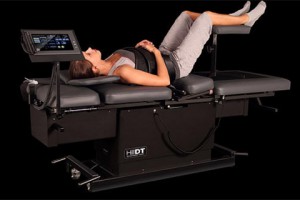
Spinal Decompression
Spinal decompression is a painless, non-invasive procedure that’s designed to relieve pressure on one or more pinched nerves running through the spinal column. The average person’s spine contains eight pairs of cervical nerves, twelve pairs of thoracic nerves, five pairs of sarcal nerves, five pairs of lumbar nerves, and one pair of coccygeal nerves. It’s not uncommon for these nerves to become pinched, resulting in symptoms like pain, limited mobility, the feeling of “pins and needles,” or even numbness. But nonsurgical spinal decompression may offer relief of these symptoms, as it relieves pressure on the affected nerves; thereby promoting a healthy musculoskeletal system.
Dr. Allen Dyer is credited with pioneering the practice of nonsurgical spinal decompression in 1985. Using a special decompression table, Dr. Dryer would reduce patients’ muscle guarding and spasms. While dozens of other decompression tables have been invented since then, the basic principle remains the same: pressure on the patient’s back is reduced by manipulating the table towards a specific angle.
So, how exactly does spinal decompression work? Methods vary depending on the chiropractor or physician performing the procedure – as well as the particular device being used – but most involve the use of a mechanical traction table that controls both the force and angle of the patient’s disc distraction. When performed correctly, it will reduce the body’s ability to resist force and general muscle spasms. Many spinal decompression tables are designed to apply traction force to the various spinal discs; thus, reducing pressure and treating the associated symptoms.
One of the great things about nonsurgical spinal decompression is the simple fact that it’s safe and non-invasive. Sure, there are other, more invasive treatment options available for back pain, herniated discs and other back problems, but they are come with a much greater risk of complication – not to mention the increased cost.
A typical spinal decompression session involves 15, one-minute long alternating decompression and relaxation cycles, making it just a half-hour long (15 minutes for decompression and 15 minutes for relaxation). When used to treat the lower back, the patient will lie on his or her back or stomach, and the chiropractor will secure the patient by placing straps around their waist and chest. Once the set of 15 decompression and 15 relaxation cycles is complete, the process is over. It’s quick, painless, and can make a world of difference in your back problems.
